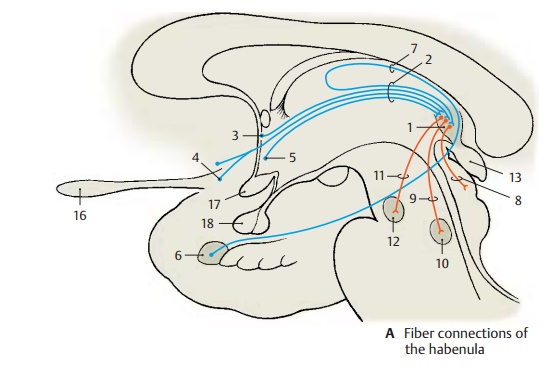Chapter: Human Nervous System and Sensory Organs : Diencephalon
Epithalamus

Epithalamus
The epithalamus includes the habenula (with habenular nuclei, habenular commis-sure, and medullary stria), the pineal gland,and the epithalamic commissure (posteriorcommissure).
Habenula (A)
The habenula (A1) with its af-ferent and efferent pathways forms a relay system in which olfactory impulses are transmitted to efferent (salivatory and motor) nuclei of the brain stem. In this way, olfactory sensation is thought to affect food intake. The habenular nucleus contains numerous peptidergic neurons.

The afferent pathways reach the habenular nuclei via the medullary stria of the thalamus (A2). It contains fibers from the septal nuclei(A3), theanterior perforated substance (ol-factory area) (A4), and the preoptic region (A5). Furthermore, it receives fibers from the amygdaloid body(amygdala) (A6) cross-ing over from the terminal stria (A7).
The efferent pathways extend into the mid-brain. The habenulotectal tract (A8) transmits olfactory impulses to the superior colliculi. Thehabenulotegmental tract (A9) terminates in the dorsal tegmental nucleus (A10), from where there is a link to the posterior longi-tudinal fasciculus with connec-tions to the salivatory and motor nuclei of the masticatory and deglutitory muscles (olfactory stimuli leading to secretion of saliva and gastric juice). The habenulo-inter-peduncular tract,Meynert’s bundle(A11), ter-minates in the interpeduncular nucleus (A12) which is connected to various nuclei of the reticular formation.
Pineal Gland (B – D)
The pineal gland (pineal body, epiphysiscerebri) (A13,B), is a small peg-shaped bodyat the posterior wall of the third ventricle above the quadrigeminal plate. Its cells, the pinealocytes, are grouped into lobules by connective tissue septa. Insilver-impregnated sections, they show long processes with club-shaped terminal swellings (C), which terminate predomi-nantly at blood vessels (D). In adults, the pineal gland contains large foci of calcifica-tion (B14), which are visible on radiographs.

In lower vertebrates, the pineal gland is a photo-sensitive organ; it registers changes from light to dark either by a special parietal eye or just by the light penetrating through the thin roof of the skull. By doing so, it influences the day and night rhythm of the organism. For example, it regulates the color change in amphibians (dark pigmenta-tion during the day, pale pigmentation at night) and the corresponding change in the animal’s be-havior. The pineal gland also registers the trans-ition from bright summertime to dark wintertime and thus brings about seasonal changes in the gonads.
In higher vertebrates, the light does not penetrate the thick roof of the skull. The rhythm of day and night is transmitted to the pineal gland through the following route: via retinal fibers to the su-prachiasmatic nucleus in the hypothalamus, then via efferent hypothalamic fibers to the interme-diolateral nucleus. and finally via postganglionic fibers of the cervical sympathetic chain to the pineal gland.
In humans, the pineal gland is thought to inhibit maturation of the genitals until puberty. As in an-imals, it is supposed to have an antigonadotropic action. Hypergonadism has been observed in some cases of pineal gland destruction in children.
Epithalamic commissure (posterior com-missure) (B).Not all fiber systems that passthrough the epithalamic commissure (B15) are known. Habenulotectal fibers cross in it. From the various pretectal nuclei that send fibers through the commissure, the intersti-tial nucleus of Cajal and Darkshevich’s nu-cleus are the most important ones. Vestibu-lar fibers are also thought to cross in this commissure.
A16 Olfactory bulb.
A17 Chiasm.
A18 Hypophysis.
B19 Pineal recess.
B20 Habenular commissure.
Related Topics